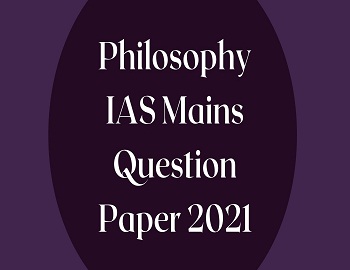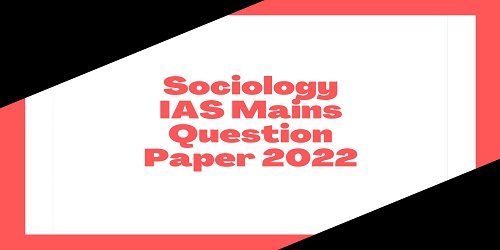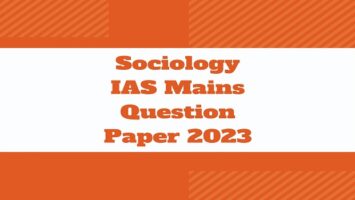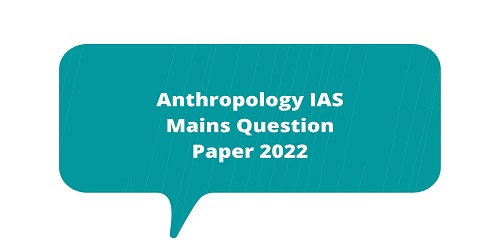Zoology IAS Mains Question Paper 2022:
There are Eight questions divided into Two Sections. Candidate has to attempt Five questions in all. Questions no. 1 and 5 are compulsory and out of the remaining, any Three are to be attempted choosing at least One question from each section.
| Zoology IAS Mains Question Paper- I: |
Section- A:
1:- Write short notes on each of the following in about 150 words: (10 x 5 = 50)
(a) Structure of visual organs of cockroach.
(b) What is meant by symmetry? Write about different types of symmetry in animals.
(c) Structure and functions of endocrine pancreas.
(d) “Cnidoblasts as defensive organs in coelenterates”. Justify.
(e) Evolutionary status of Sphenodon.
2:- (a) Explain asexual and sexual modes of reproduction in Paramecium. (20)
(b) Write general features of egg laying mammals, pouched mammals and aquatic mammals. (15)
(c) Describe different types of scales in fishes with suitable diagrams. (15)
3:- (a) Explain habitat, habits, general features and life cycle of Wuchereria. (20)
(b) Describe different types of canal system found in porifera. Also mention their functions. (15)
(c) Draw a suitable diagram and explain the structure of human eye. (15)
4:- (a) Give an account of the origin as well as adaptive radiation of reptiles. (20)
(b) Describe general structure of a mammalian tooth. Also, classify mammalian teeth based on their shape, attachment and succession. (15)
(c) Describe habitat, habits and general features of Herdmania. Write a note on its development. (15)
Section- B:
5:- Write short notes on each of the following in about 150 words: (10 x 5 = 50)
(a) What are ecotones? Explain by giving examples. Also write a note on ‘edge effect’.
(b) Comment on ‘measures of central tendency of data’.
(c) Describe principle, working mechanism and applications of gel electrophoresis.
(d) ‘Conditioned learning’ in animals.
(e) Klinefelter’s syndrome and Turner’s syndrome in humans.
6:- (a) Describe various types of social groupings in primates. Write a note on importance of social grouping.
(b) (i) Differentiate between primary and secondary pollutants. (5)
(ii) Explain primary and secondary treatment of waste water. (10)
(c) What is Chi-square analysis? Explain its applications in biology. (15)
7:- (a) What is meant by biodiversity? Explain various means of in situ conservation of biodiversity. (20)
(b) Describe two basic laws of learning. Explain habituation, trial and error learning and latent learning in animals. (150)
(c) Write principle, working mechanism and uses of PCR. (15)
8:- (a) Mention the causative agent and means of spread of tuberculosis. Also describe symptoms, diagnosis, treatment and preventive measures of tuberculosis. (20)
(b) Explain biological, non-biological and industrial fixation of nitrogen. (15)
(c) What is gene therapy? Citing suitable examples explain germline and types of somatic cell gene therapy.
| Zoology IAS Mains Question Paper- II: |
Section- A:
1:- Write your answer in about 150 words for each of the following: (10 x 5 = 50)
(a) Draw the structure of a microtubule and explain its role in chromosomal movements during cell division.
(b) What is mutation? Write a brief note on various types of point mutations.
(c) Give schematic organization of cosmid. Why is it preferred over plasmid for gene cloning?
(d) Explain Hardy-Weinberg law of equilibrium and mention the factors that upset the equilibrium.
(e) Write a note on the theory of natural selection.
2:- (a) What is rough endoplasmic reticulum (RER)? Describe in detail the various modification of secretory proteins occurring in the human RER. (20)
(b) Define endomitosis. Describe in detail the structure of a polytene chromosome highlighting the importance of puffs. (15)
(c) what is facilitated diffusion? Describe the mechanism of active transport across the plasma membrane with suitable example. (15)
3:- (a) Sketch out a basic transcription unit and illustrate the RNA polymerase II associated assembly of a transcription initiation complex during expression of a eukaryotic gene. (20)
(b) Illustrate the steps of constructing a recombinant c-DNA from an m-RNA. (15)
(c) Explain the following: (15)
(i) Stepwise intrinsic mechanism of apoptotic induction
(ii) Principle of DNA fingerprinting
4:- (a) What is fossil? Describe the origin and evolution of horse based on the fossil records. (20)
(b) Define variation. Describe different types of variations and their role in evolution. (15)
(c) What is biodiversity? Describe the major types of biodiversities found in nature. (15)
Section- B:
5:- Write your answer in about 150 words for each of the following: (10 x 5 = 50)
(a) Define immunity. Explain cell-mediated immune response in vertebrates with suitable diagram.
(b) Describe the structure and functions of mammalian placenta.
(c) Explain the functions of neutrophils, basophils and lymphocytes.
(d) Illustrate the counter-current mechanism by vasa recta and mention its physiological importance.
(e) Define biogenetic law. Write the characteristics of Haeckel’s theory of recapitulation.
6:- (a) Draw the molecular structure of ATP synthase and diagrammatically explain the chemiosmotic concept of ATP synthesis. (20)
(b) Illustrate the following: (15)
(i) A = T and G = C base pairing as a part of DNA double strand
(ii) Michaelis-Menten kinetic pattern of an enzymatic reaction
7:- (a) What are intestinal glands? Describe the roles of intestinal juices in digestion and absorption of food. (20)
(b) Define thermoregulation. How do homeotherms regulate body temperature in hot and cold climates? (15)
(c) Draw the structure of retina and explain the mechanism of vision in mammalian eye. (15)
8:- (a) What is stem cell? Discuss the types of stem cells and their application in therapeutic uses in human. (20)
(b) Explain the mechanism of spermatogenesis in mammals with suitable diagram. (15)
(c) Describe the hormonal regulation of metamorphosis in amphibians. (15)









Comments (No)